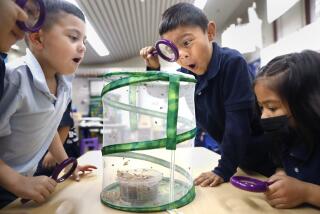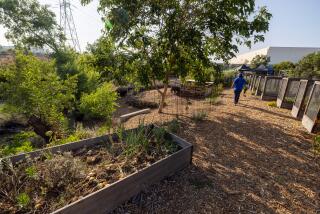School Is Child’s Play : Curriculum Designed to Meet Needs of Each Kindergartner
- Share via
LAKE FOREST — This is the premiere of A-Plus, a weekly View feature that will spotlight outstanding teachers, innovative programs and exemplary accomplishments in Orange County public schools. Please send names and phone numbers of people you would like to see profiled here to A-Plus, Times Orange County View, 1375 Sunflower Ave., Costa Mesa, Calif. 92626.
Sitting at the piano, Cathy Wietstock glances around the room, sizing up her audience. Most people are clustered in small groups, chattering. Suddenly, Wietstock hits the keys and breaks into song.
The audience snaps to attention.
Wietstock is not a Las Vegas performer. She’s a kindergarten teacher, playing daily to a tough audience of 5- and 6-year-olds at La Madera School. There, Wietstock and her teaching partner, Sue Baldwin, run an innovative kindergarten class that is two hours longer than the typical class.
The program, which began in March, grew out of a state task force recommendation suggesting that young children would be better prepared for first grade if kindergarten hours were extended.
“The kids have lunch at school and are able to spend more time with teachers,” Wietstock says. “Before, everything was driven by the clock. Now, they can work on something to completion.”
The extended program is good for the kids and has been popular with parents, says Viva Jones, principal at La Madera.
“We have found that using the right kind of teaching techniques, it helps the children,” Jones says.
The program, which includes two classes taught by Wietstock and one taught by Baldwin, has 65 pupils, all learning at different levels, says Wietstock, who holds a master’s degree in educational psychology.
Wietstock, who is 32 and has been teaching for 12 years, is one of California’s approximately 200 certified trainers for a program called Early Intervention for School Success. The program, in more than 400 schools statewide, is aimed at educating young children by developing a curriculum to meet the child’s needs--instead of expecting the child to fit the needs of the curriculum.
“The philosophy in the ‘70s and ‘80s was teach kids to read in kindergarten,” she says. “That’s changed. Now we’re pushing the academics back up to the first and second grades. First-grade teachers love it because when they get these kids they are really ready to learn.”
La Madera School is one of several demonstration sites in Southern California, and teachers come from all over to observe Wietstock’s class, which runs from 8:50 a.m. to 1:45 p.m.
A child’s progress is measured through observation and charted by means of individual portfolios consisting of samples of each child’s work. That work might include drawings, stories, tape recordings and writings that show how the child’s skills are developing.
What do children learn in kindergarten?
Wietstock grows thoughtful. “I really believe that we’re still using things we learned in kindergarten. That’s really a true philosophy. They learn math, counting, social skills, colors, language, writing, spelling. And they go away with positive self-esteem, proud of who they are and with knowledge they can succeed.”
She pauses and gestures around the room. “People think that kindergarten is nap time, cookies and milk. But we even work on physics, geometry.”
But all of that is taught in a very non-academic setting--in an atmosphere that resembles play, not work.
As principal Viva Jones said: “Play is the work of the child, and we put that play into the environment of the class so that it becomes embedded learning.”
During free time, pupils get to choose from among dozens of activities, ranging from painting to numbers games. Wietstock calls the segment “organized chaos,” and the children seem to love it. As the children “play,” Wietstock buzzes around the room, stopping here and there to connect with each child.
In the building-block area, three boys are constructing a make-believe garage, complete with cars and trucks. In the post office section, a girl counts out play money. In another corner, a boy arranges numbers on the floor and shows off his mathematical abilities.
“One and one equals two,” he says. “Ten and 10 equals 20 and 100 and 100 equals 200.”
Wietstock stands back, eyes sweeping the room, obviously pleased with the children’s individual accomplishments.
“This type of activity lends itself to everyone’s level,” she says, pausing to inspect a complicated geometric shape being built by a creative 5-year-old. “We work from the concrete to the representational. We try to keep all our math hands on, for example. You have to experience it to learn how to do it. “
Maintaining an orderly classroom in such a free-for-all atmosphere is accomplished through what Wietstock calls intrinsic control.
“From the beginning, we talk about how I don’t like to be the heavy,” she says. “We teach them intrinsic self-control so no one has to remind them all the time.”
When free time is over, and the children are supposed to sit cross-legged on the floor, hands on lap, they do it without complaint. When the lights blink off and on during free time, the children all stop what they are doing and sit quietly, hands on their heads, while Wietstock gently reminds them that now is the time to go to the restroom or get a drink of water.
Visitors, including 17 teachers from San Diego who dropped by to observe the class recently, are impressed with the orderliness and creativity of Wietstock’s classroom.
“We have in each nook and cranny something for the children to learn with,” she says proudly. “We read to them constantly, two or three books a day. We sing, do puppets and tell stories. In other words, we learn through our play.”
For the children it may be play, but Wietstock, herself the mother of two children, ages 6 and 4, takes it all quite seriously. When she talks about education, she speaks from the heart.
“We are entrusted with a parent’s most precious gift and that is a big responsibility,” she says. “Kindergarten is a foundation for all grade levels, and without education we are lost.”
She pauses for a moment and glances around the room at a sea of eager faces, then grins, knowing the next words are going to sound corny. “Children are our future,” she says. “That may be cliche, but true.”
More to Read
Sign up for Essential California
The most important California stories and recommendations in your inbox every morning.
You may occasionally receive promotional content from the Los Angeles Times.










